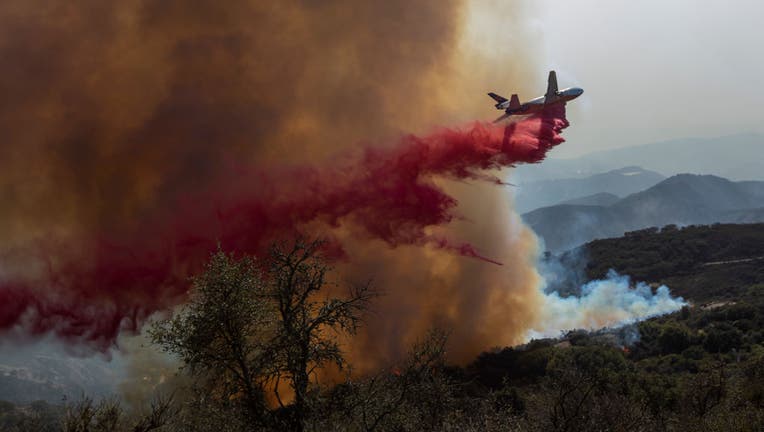Firefighters make progress coralling Santa Barbara wildfire

GOLETA, CA - OCTOBER 13: A firefighting jet drops fire retardant as the Alisal Fire burns on October 13, 2021 near Goleta, California. Pushed by high winds, the Alisal Fire grew to 6,000 acres overnight, shutting down the much-traveled 101 Freeway al
SANTA BARBARA, Calif. - Firefighters reported significant progress in corralling a wildfire in Southern California coastal mountains on Friday.
The Alisal Fire in the Santa Ynez Mountains west of Santa Barbara grew only slightly since Thursday morning to 26.4 square miles and containment of the blaze jumped to 41%, up from 5% 24 hours earlier.
The improved situation allowed authorities Thursday evening to reopen of U.S. 101, the region's main highway, and a rail line that runs next to the highway. They had been closed since Monday.
In its first damage report, the Santa Barbara County Fire Department said that of more than 400 structures that were threatened by the fire, three homes and two outbuildings were destroyed.
The fire erupted during fierce winds Monday afternoon and spread rapidly down the face of the mountain range, leaping the highway and railroad to the beach below.
Firefighting weather greatly improved since then, allowing airplanes and helicopters to bombard the fire with retardant and water. The firefighting ground force has grown to more than 1,700 firefighters.
Elsewhere in California, gusty winds and low humidity triggered red flag warnings for extreme fire danger in much of adjacent Ventura and Los Angeles counties, but the rest of the state was free of critical fire danger warnings.
Some rain and snow was expected Sunday in Northern California, and long-range National Weather Service forecasts suggested a possible pattern of more significant precipitation that would help ease wildfire risks.
California wildfires have scorched nearly 3,900 square miles this year and destroyed more than 3,600 homes, businesses and other structures, according to the state Department of Forestry and Fire Protection.
A historic drought in the American West tied to climate change is making wildfires harder to fight. It has killed millions of trees in California alone. Scientists say climate change has made the West much warmer and drier in the past 30 years and will continue to make weather more extreme and wildfires more frequent and destructive.

